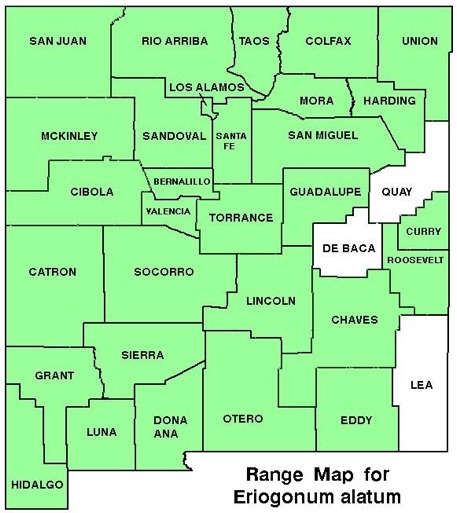WILDFLOWERS OF NEW MEXICO

New Mexico’s tallest buckwheat has a single, 20–50-inch tall stem with numerous fuzzy-hairy, side branches. It sprouts from an overwintering basal rosette of hairy leaves that gradually taper to the base (not spoon shaped). Each of the open-spreading, mostly leafless branches bears clusters of tiny, yellow flowers. The basal rosette grows 3–7 years before the plant blooms once and dies.
FLOWER: June–October. The tiny 1/4-inch (3 mm) wide, lemon-yellow flowers have 6 pointed, petal-like sepals and showy, extended stamen. Prominent yellow-greenish seeds have 3 wings and mature rusty-reddish. Seeds hang on short stems in tight, round clusters.
LEAVES: Basal and alternate on stem. The basal leaves sometimes form thick mats of 2–7 3/4-inch long (5–20 cm) blades that vary from lance- to spatula-shaped with entire margins. Long hairs line the margins and midribs. Winter basal leaves often have a reddish tint. Alternate stem leaves, if present, are 3/8–2 3/8-inches long (1–6 cm), and get smaller up the stem.
HABITAT: Dry sandy, gravelly soils; desert scrublands, grasslands, pinyon-juniper-oak woodlands, mixed conifer forests.
ELEVATION: 4,400–9,000 feet.
RANGE: AZ, CO, KA, NE, NM, NV, OK, TX, UT.
SIMILAR SPECIES: Buckwheats love NM with about 43 species, many very similar. Two varieties of E. alatum in NM have slight differences. The flowering stems are hairy in variety alatum, the most common, and hairless in variety glabriusculum, recorded in Curry County. Many other tall species grow within this range. Redroot Buckwheat, E. racemosum, has a single, leafless stem with several erect upper spike-like flowering branches and spoon-to spatula-shaped basal leaves. Annual Buckwheat, E. annuum, has rounded, very hairy clusters of white flowers, a leafy stem, and a basal rosette of leaves that usually withers by blooming.
NM COUNTIES: Statewide, except De Baca, Lea, Quay, Roosevelt counties, in mid-elevation, dry habitats.









WINGED BUCKWHEAT
ERIOGONUM ALATUM
Buckwheat Family, Polygonaceae
Perennial herb (short-lived)



























THE CONTENTS OF THIS WEBSITE ARE COPYRIGHTED AND CANNOT BE USED
WITHOUT PERMISSION OF GEORGE OXFORD MILLER











































EMAIL ME







